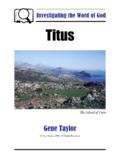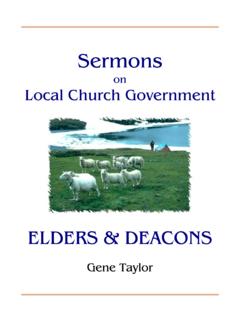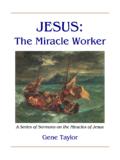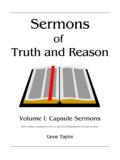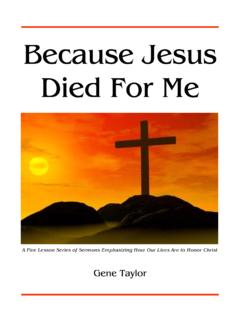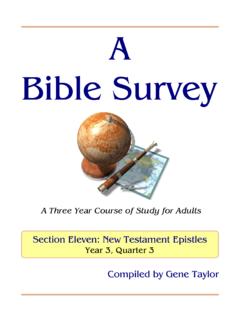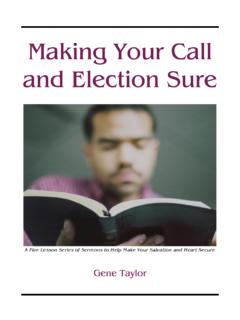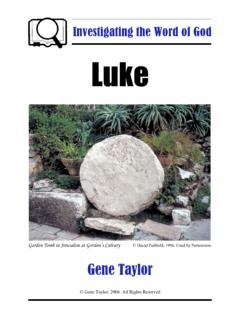Transcription of Philemon - New Testament Study Guide - Gene …
1 investigating the Word of GodPhilemonThe Roman Theater at ColosseGene taylor gene taylor , 2006. All Rights the Word of God: Philemon gene taylor -1-An Introduction to PhilemonPhilemon. He was a resident of Colosse and the church seems to have assembled in his house ( ). He must have been converted by Paul at either Ephesus or elsewhere (v. 19). Evidently, hewas a wealthy slave owner since Onesimus was his property (vv. 10-11, 16). His house was largeenough to serve as a meeting place for the church (v. 2). His benevolence and generosity towardhis fellow Christians is cited in verses five through seven.
2 The apostle Paul requested of him aplace to lodge (v. 22). Probably Apphia was Philemon s wife, and Archippus, their son. (William S. Deal, Baker s Pictorial Introduction to the Bible, p. 387)Onesimus. He was a slave of Philemon who had run away. Verse 18 implies that he may havestolen money from his master to effect his get-away. He fled to Rome which would serve as apopulous haven to conceal him. In Rome, he came under the influence of the apostle Paul. Twosuggested possibilities as to how this came about. (1) Epaphras had come from Colossae at thistime to visit Paul (Col.)
3 1:7-8; 4:12-13). He may have seen and recognized Onesimus and broughthim to Paul. (2) Onesimus may have exhausted his funds and stood in desperate need. He mayhave been familiar with the name of Paul and his situation and turned to him as a last resort. He endeared himself to Paul as another son in the faith (v. 10) so much so that Paul wanted tokeep him in Rome (v. 13). Since Onesimus belonged to Philemon , Paul sent him back to him atColossae with Tychicus who carried the Colossian epistle along with this letter to Philemon ( :7-9).
4 The Author of the Book From the most ancient times, the Pauline authorship of this letter has never been questioned. (Deal, 387)In the book, the author refers to himself three times as Paul (vv. 1, 9, 19). The book s similarityto the book of Colossians (1, 2, 23-24; cf. Col. 4:1-17) suggests that the books were written at thesame time, at the same place and by the same the Word of God: Philemon gene taylor -2-The Date of the Book and Its Delivery to Philemon Philemon is one of the four Prison Epistles (Ephesians, Philippians, and Colossians were theothers).
5 It was written in 60 or 61 and dispatched at the same time as Colossians duringPaul s first Roman imprisonment. (Nelson s Complete Book of Bible Maps & Charts, p. 438)That Paul was in prison is seen in that: (1) His listed associates were with him during his Romanconfinement (vv. 1, 23-24); (2) He identified himself twice as a prisoner of Jesus Christ (vv. 1,9) and as the aged (v. 9). Both of these distinctions would fit Paul s first Roman confinement. It seems quite clear that this letter must have been written during Paul s first Roman imprisonment,possibly about the time Colossians and Ephesians were written.
6 Some think it was Paul s first epistlewhile in , Paul wrote this epistle just as he was arranging to send epistles to theColossian and Ephesian churches. Tychicus apparently agreed to accompany Onesimus back toColossae, taking the Colossian and Ephesian epistles. This was probably about 61. (Deal)Why This Book Was Written This very heart-warming letter was written by Paul for the purpose of interceding for therunaway slave who had become a faithful Christian, and not only pleading for mercy for himfrom his master, but also to remind his master of his duty as a fellow Christian toward thispenitent slave.
7 (Roy Cogdill, The New Testament Book-by-Book, p. 117) In this intimate letter Paul thus wrote to commend Philemon for his Christian compassiontoward the needs of fellow believers (1-7); to effect the forgiveness and restoration of Onesimusby Philemon (8-21); to announce plans of a future visit, based upon his hopes of an imminentrelease (22); and to send greetings from many of Paul s associates who were probably known toPhilemon (23-25). (Robert G. Gromacki, New Testament Survey, p. 314)The Themes of the BookBrotherly love.
8 Paul s epistle to Philemon is a testimony to the power of the grace of God inChrist Jesus and to the Christian love which unites believers. While he was formerly a thief andrunaway slave, Philemon s slave Onesimus had been transformed by God s grace and was now a beloved brother of Philemon (v. 16). (Nelson s, p. 440) Does Christianity really work? Is the principle of Christian love and forgiveness reallyapplicable, practical and possible in difficult daily dealings?..Paul s brief post-card toPhilemon reveals that he had no doubt.
9 This is the Savior s message put to application. This isChristian love put to the test. This is forgiveness exemplified. (Wilson Adams, Bible Survey [anunpublished work], p. 304)This book illustrates how brotherly love works. Love: is grateful for the best in others (v. 4);seeks the welfare of others (v. 10); deals honestly with others (v. 12); bears the burdens of others(v. 18); and believes the best of others (v. 21).Slavery. This letter gives us a clear picture of social and domestic life in New Testament was one of the common practices of the ancient world.
10 People then saw no more wrongin having slaves than in having domestic servants. Some authorities think that within the RomanEmpire there were perhaps 60 million of these slaves. This grievous condition was so common itInvestigating the Word of God: Philemon gene taylor -3-could not be uprooted immediately, so Christianity regulated it with such principles as to makerighteous conduct toward it possible, while at the same time, making it very difficult to continueits inequities and be what Christians ought to letter suggests that social and inequitableevils in this world are not to be solved by revolution or violence but by Christian influence andteaching.
